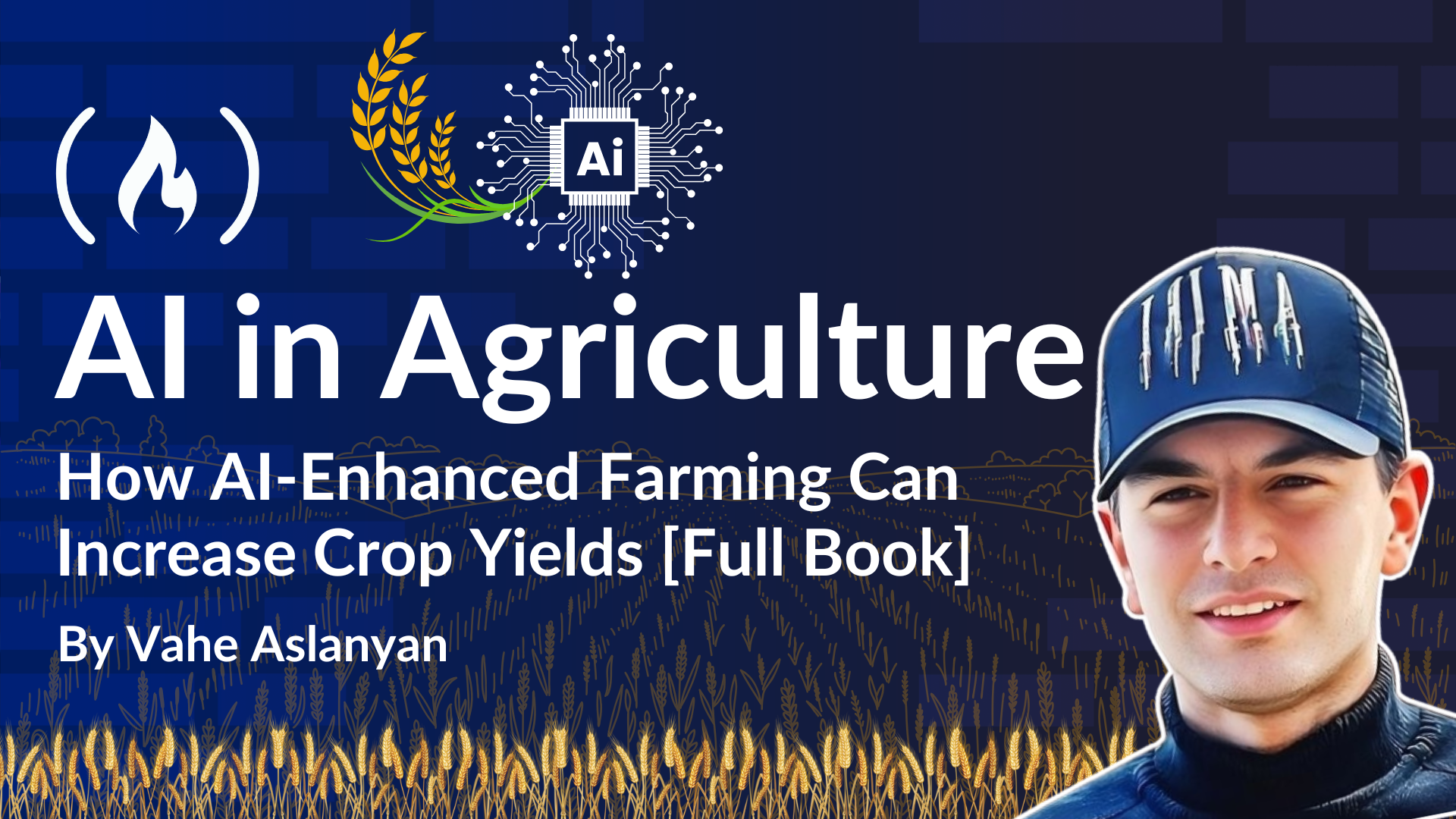
Chapter 4: Predictive Analytics and Machine Learning in Crop Yield Improvement
Chapter 4: Predictive Analytics and Machine Learning in Crop Yield Improvement 관련
The advancements of AI in agriculture herald a transformative era where crop yields may potentially rise by as much as 70% by 2030. This leap hinges on the effective use of predictive analytics and machine learning, two potent tools that are dramatically reshaping the landscape of modern farming.
Let's delve deeply into how these technologies can elevate agricultural practices and drive substantial improvements in crop yield.
Predictive Analytics: Optimizing Agricultural Processes
Predictive analytics leverages historical data, real-time information, and weather patterns to provide farmers with actionable insights. This highly nuanced approach facilitates precise decision-making, thus optimizing the entire agricultural value chain.
Imagine a farmer who has consistently struggled with unpredictable weather and its impact on planting schedules. By utilizing predictive analytics, historical weather patterns can be analyzed alongside real-time meteorological data to forecast the optimal planting period. This allows the farmer to sow crops under conditions most conducive to their growth, thus enhancing the probability of higher yields.
Predictive analytics also helps in fine-tuning irrigation strategies. Water scarcity is a persistent challenge in agriculture, particularly in arid regions. By analyzing soil moisture levels and weather forecasts, farmers can precisely schedule irrigation, ensuring plants receive the exact amount of water they need without wastage. This not only conserves water but also promotes healthier crop growth, which directly translates to improved yields.
Plant protection is another area where predictive analytics excels. By observing historical pest invasion data and current climatic conditions, farmers can predict pest outbreaks and implement timely, targeted interventions. Such foresight prevents extensive crop damage and reduces the dependency on chemical pesticides, fostering a more sustainable agricultural practice.
Machine Learning in Intelligent Decision-Making
Machine learning algorithms further elevate the capabilities of predictive analytics by enabling the creation of highly personalized AI models. These models are specifically tailored to a farm's unique characteristics—soil type, crop variety, local climate conditions—and can process vast datasets to offer precision farming recommendations.
Consider a scenario where a farm's soil is nutrient-deficient. Traditional methods might rely on broad-spectrum fertilizers, often leading to nutrient imbalance and soil degradation. But with machine learning, farmers can analyze soil samples to determine the specific nutrient deficiencies and develop custom fertilizer blends that address these gaps precisely. Over time, as the model ingests more data, its recommendations become more accurate, ensuring that crops receive optimal nutrition, which significantly boosts yields.
Machine learning can also revolutionize crop variety selection. Season after season, choosing the right crop variety to plant is a critical yet challenging decision. By analyzing data from past harvests, climate patterns, and market demands, machine learning models can predict which crop varieties are most likely to thrive and be profitable in a given region and season. This data-driven approach minimizes the guesswork and enhances the likelihood of successful harvests.
Empowering Farmers with Data-Driven Insights
The integration of predictive analytics and machine learning empowers farmers with real-time, data-driven insights, transforming agriculture into a precision-driven industry. Access to such precise information enables quick and informed decisions that maximize resources and mitigate risks.
Take, for example, the task of monitoring soil health. Traditionally, farmers relied on sporadic soil tests, which might miss critical variations in soil conditions. With continuous data collection through sensors and real-time analytics, farmers can monitor soil health consistently. If a sudden drop in soil moisture is detected, an immediate analysis can identify the cause, prompting timely corrective actions such as adjusted irrigation or the application of mulching to conserve moisture.
Weather predictions enhanced through machine learning algorithms also play a pivotal role. Real-time weather data can be continuously analyzed to detect emerging patterns or anomalies that might affect crop growth. For instance, an impending storm that could potentially cause flooding can be predicted, allowing farmers to apply preemptive measures such as improving drainage systems or temporarily covering crops to protect them.
Moreover, management practices can be adjusted dynamically based on insights from data on plant health. Advanced sensors can monitor plant conditions, identifying early signs of disease or nutrient deficiency. With immediate feedback, farmers can apply the necessary treatments long before visible symptoms appear, thus saving crops and increasing yields.
Advanced Insights for Sustainable Farming
Beyond immediate yield improvements, predictive analytics and machine learning promote sustainable farming practices by optimizing resource use and minimizing environmental impact.
Precision in fertilizer application, as discussed earlier, prevents over-fertilization and reduces the risk of groundwater contamination. Similarly, efficient water use strategies ensure that valuable freshwater resources are conserved, which is especially crucial in regions facing water scarcity.
By promoting sustainable practices, these technologies help build resilient agricultural systems capable of withstanding the adverse effects of climate change. For example, predictive models that anticipate climate variability and its impact on crop cycles enable farmers to adapt their strategies proactively. This adaptive capacity is vital for maintaining productivity as weather patterns become increasingly unpredictable.
Concrete Examples of Success
Real-world applications of these technologies offer compelling evidence of their efficacy. In the United States, the USDA has been leveraging predictive analytics to forecast corn yield with remarkable accuracy. By integrating satellite imagery, weather data, and advanced analytics, the USDA can predict yield variations and guide farmers in optimizing their practices accordingly.
In India, machine learning models have been employed to improve rice yields. By analyzing soil health, weather patterns, and pest data, these models provide tailored advice to farmers, resulting in significant yield increases. The model's success in one of the most challenging agricultural environments underscores the transformative potential of AI-driven solutions in diverse settings.
Code Examples
Here are two examples that demonstrate how LLM (Large Language Models) applications can be integrated into the predictive analytics and machine learning aspects of agriculture to enhance crop yield optimization and sustainable farming practices.
Example 1: Predictive analytics for optimizing agricultural processes
Objective: Utilize an LLM to generate insights for a farmer on the optimal planting, irrigation, and pest control schedules based on historical weather patterns, real-time meteorological data, and soil moisture levels.
import openai
from datetime import datetime
# Sample data on historical and current weather, soil moisture, and pest data
agricultural_data = {
"historical_weather": "Over the past 10 years, this region has experienced optimal planting conditions between March 15 and April 10, with a dry spell in mid-April.",
"current_weather": {
"today": {"temperature": 25, "humidity": 60, "precipitation": 0, "wind_speed": 10},
"forecast": [
{"date": "2024-03-18", "temperature": 22, "humidity": 55, "precipitation": 5},
{"date": "2024-03-19", "temperature": 24, "humidity": 50, "precipitation": 0}
]
},
"soil_moisture": 35, # percentage
"pest_risk": "Based on historical pest data and current climate conditions, there is a high risk of pest outbreaks in late April."
}
# Create a readable summary of the data for the LLM
data_summary = (
f"Historical weather data: {agricultural_data['historical_weather']}. "
f"Today's weather: Temperature {agricultural_data['current_weather']['today']['temperature']}°C, "
f"Humidity {agricultural_data['current_weather']['today']['humidity']}%, "
f"Precipitation {agricultural_data['current_weather']['today']['precipitation']}mm, "
f"and Wind Speed {agricultural_data['current_weather']['today']['wind_speed']} km/h. "
f"Soil moisture is currently {agricultural_data['soil_moisture']}%. "
f"Pest risk: {agricultural_data['pest_risk']}."
)
# Use an LLM to generate actionable insights for the farmer based on this data
response = openai.ChatCompletion.create(
model="gpt-4",
messages=[
{"role": "system", "content": "You are an expert in agriculture with a focus on predictive analytics."},
{"role": "user", "content": f"Based on the following data, suggest optimal planting, irrigation, and pest control strategies: {data_summary}"}
]
)
recommendations = response.choices[0].message['content']
print(recommendations)
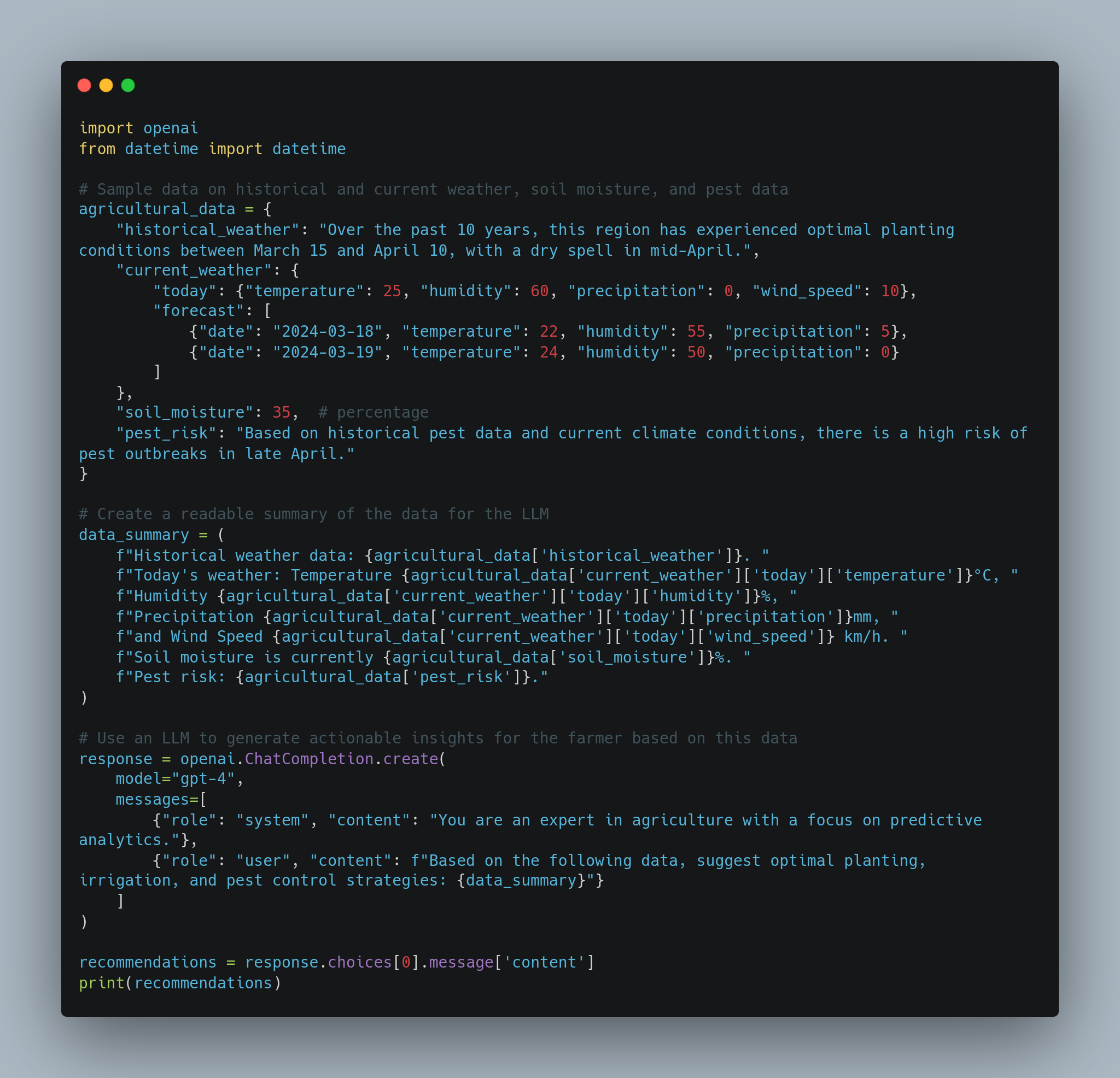
lunartech.ai
**Optimal Planting Strategy:**
Based on historical data, the ideal planting window is between March 15 and April 10. Given the current weather forecast and soil moisture level of 35%, it is advisable to begin planting on March 19, when temperatures will be around 24°C and precipitation is expected to be minimal.
**Irrigation Strategy:**
With soil moisture at 35%, irrigation is not urgently required today. However, monitor moisture levels closely over the next week, especially after March 19. If the soil moisture drops below 30%, consider scheduling irrigation in the early morning or late evening to reduce evaporation.
**Pest Control Strategy:**
There is a high risk of pest outbreaks in late April. It is recommended to implement preventative measures, such as applying organic pest deterrents, during the second week of April. Regular monitoring of pest activity during this period is crucial to prevent damage to crops.
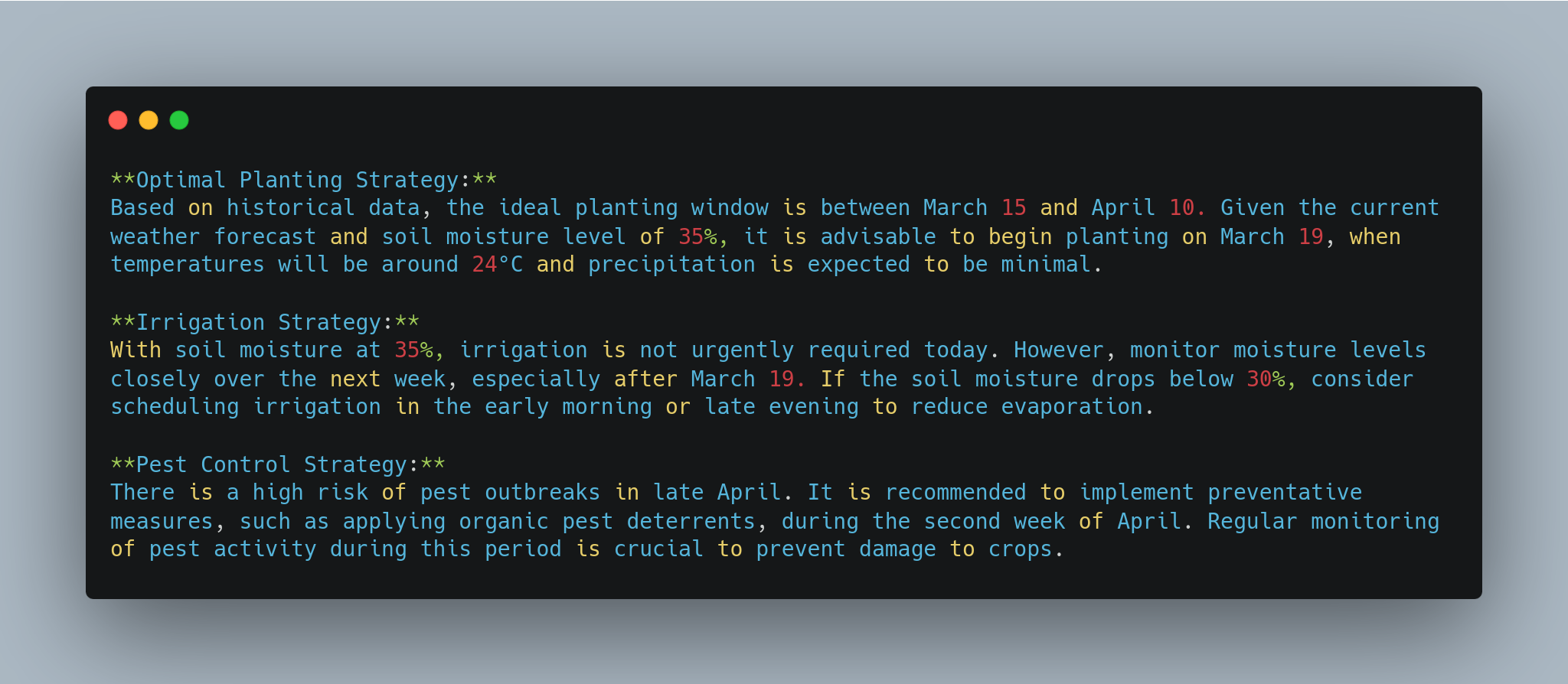
lunartech.ai
Example 2: Machine Learning for intelligent decision-making in agriculture
Objective: Use an LLM to generate recommendations for custom fertilizer blends and optimal crop variety selection based on machine learning models that analyze soil type, nutrient levels, and local climate data.
import openai
# Sample soil and climate data for a farm
farm_data = {
"soil_type": "clay",
"soil_nutrients": {"nitrogen": 30, "phosphorus": 15, "potassium": 40}, # ppm
"climate_conditions": {"average_temperature": 28, "rainfall": "moderate", "humidity": 65},
"historical_crop_yield": {
"wheat": {"yield_per_hectare": 3000},
"corn": {"yield_per_hectare": 2800},
"rice": {"yield_per_hectare": 4000}
}
}
# Convert farm data to a readable description
farm_description = (
f"The farm's soil is clay-based, with nutrient levels of nitrogen at {farm_data['soil_nutrients']['nitrogen']} ppm, "
f"phosphorus at {farm_data['soil_nutrients']['phosphorus']} ppm, and potassium at {farm_data['soil_nutrients']['potassium']} ppm. "
f"Climate conditions include an average temperature of {farm_data['climate_conditions']['average_temperature']}°C, "
f"moderate rainfall, and humidity at {farm_data['climate_conditions']['humidity']}%. "
f"Historical yields for wheat, corn, and rice have been 3000, 2800, and 4000 kilograms per hectare, respectively."
)
# Use an LLM to suggest custom fertilizer blends and optimal crop variety based on this data
response = openai.ChatCompletion.create(
model="gpt-4",
messages=[
{"role": "system", "content": "You are an agricultural expert with a focus on machine learning and crop yield optimization."},
{"role": "user", "content": f"Based on the following farm data, suggest a custom fertilizer blend and optimal crop variety for the upcoming season: {farm_description}"}
]
)
crop_and_fertilizer_recommendations = response.choices[0].message['content']
print(crop_and_fertilizer_recommendations)
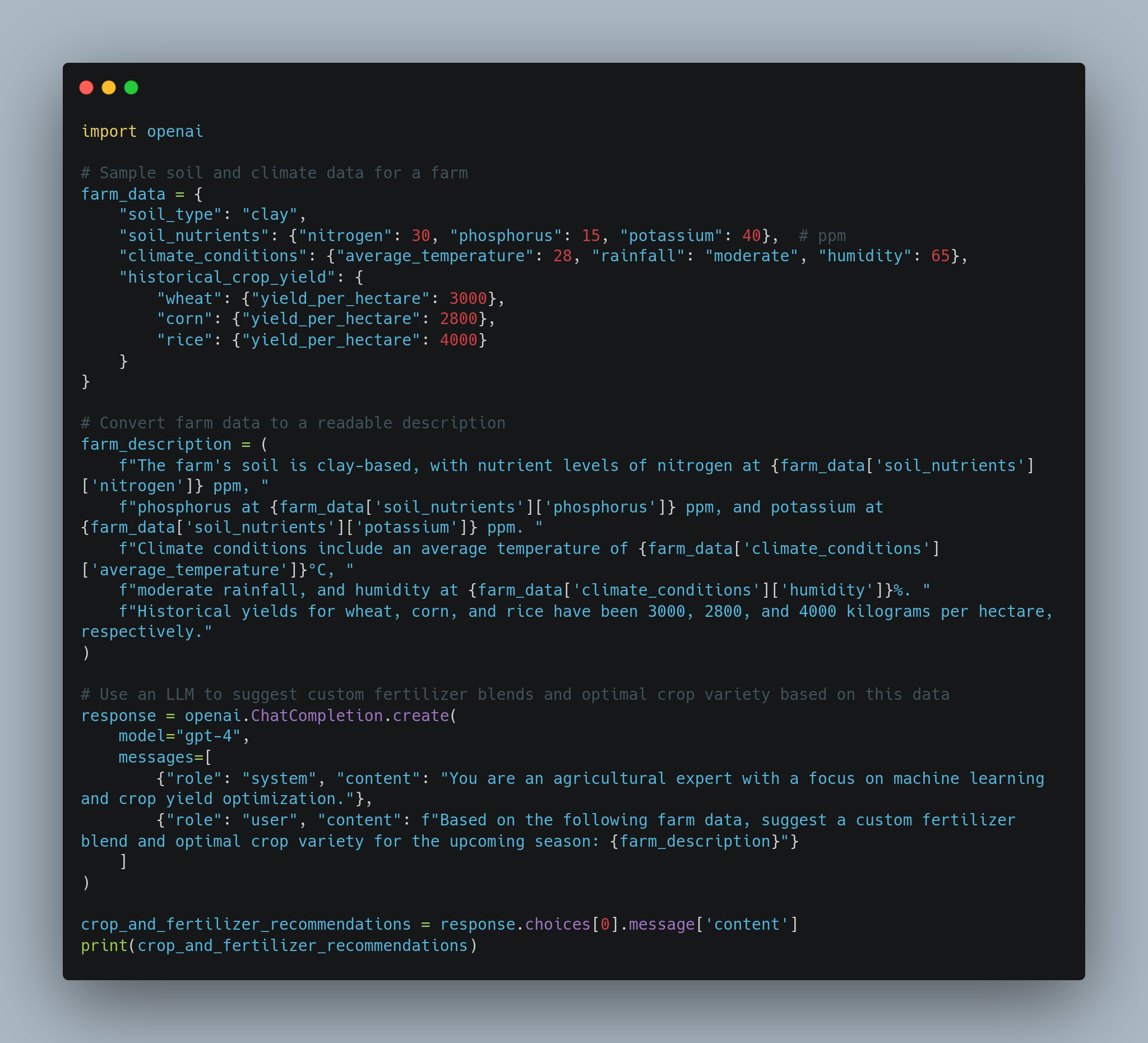
lunartech.ai
**Custom Fertilizer Blend Recommendation:**
Given the nutrient levels in your clay soil (30 ppm nitrogen, 15 ppm phosphorus, 40 ppm potassium), it is recommended to apply a balanced fertilizer with the following ratio:
- Nitrogen: 40%
- Phosphorus: 25%
- Potassium: 35%
You can achieve this blend by combining urea (for nitrogen), triple superphosphate (for phosphorus), and potassium sulfate. Apply the fertilizer before the planting season and follow up with additional nitrogen during the growth phase, especially for nitrogen-hungry crops like wheat.
**Optimal Crop Variety Recommendation:**
Based on the climate conditions (28°C average temperature, moderate rainfall, and 65% humidity), the optimal crop variety for your farm would be rice. Rice has historically produced the highest yield on your farm (4000 kg/hectare) and performs well in clay soil with moderate water availability. Choose a high-yield, drought-resistant rice variety for this season to maximize output while minimizing water usage.
Wheat is also a viable option, but with lower yield potential. However, if market demand is higher for wheat, consider alternating crops or employing crop rotation to maintain soil health.
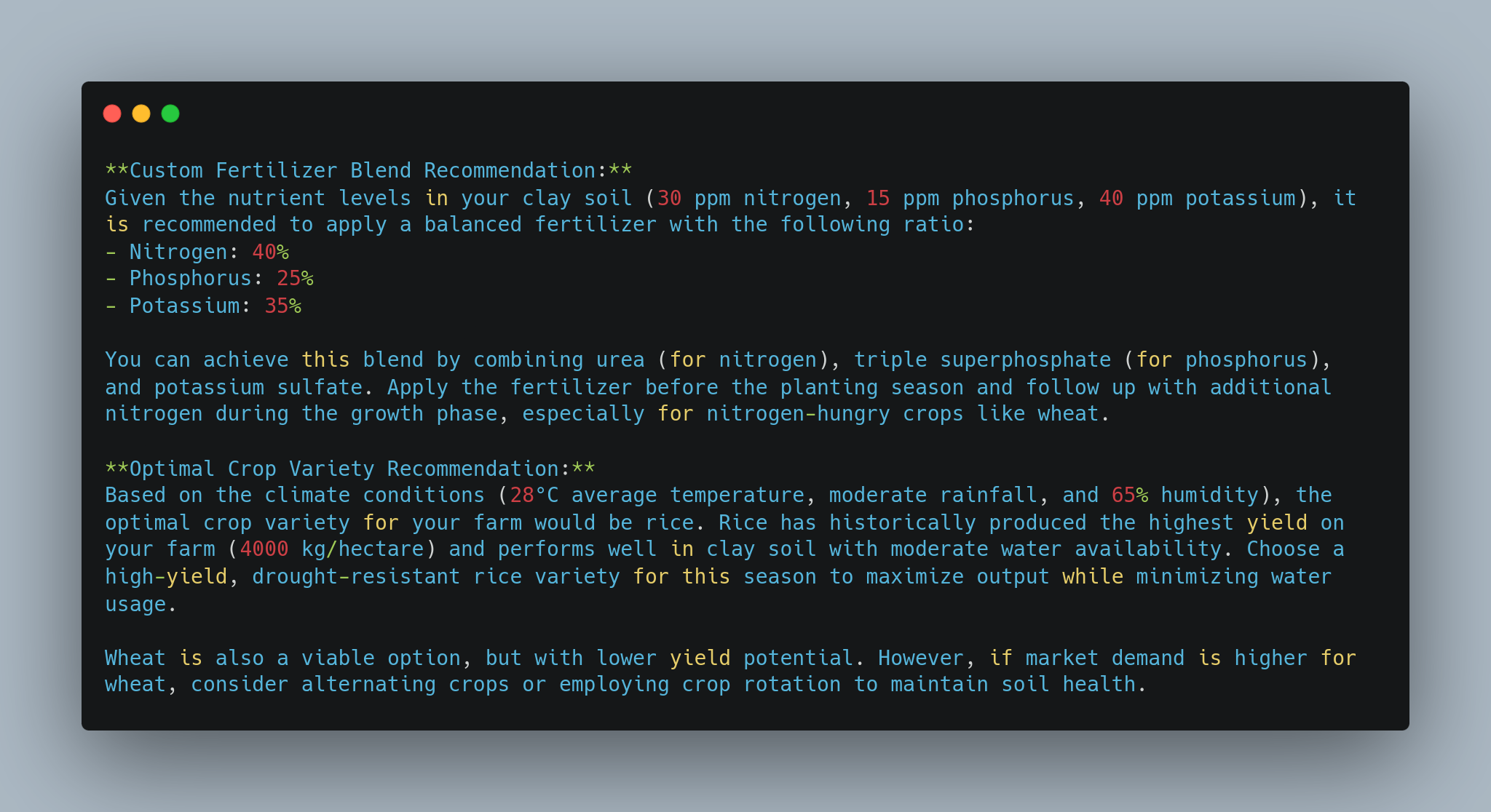
Example 1 demonstrates the use of predictive analytics with an LLM to provide actionable recommendations for optimal planting, irrigation, and pest control schedules based on historical weather patterns, real-time data, and soil conditions.
Example 2 showcases machine learning applied to agriculture, where an LLM generates custom fertilizer recommendations and suggests the optimal crop variety based on farm-specific data such as soil nutrients, climate conditions, and historical crop yield performance.
In both examples, LLMs act as a powerful interface between the data and the farmer, providing tailored insights to optimize decision-making and enhance crop yields.
As you can see, the integration of predictive analytics and machine learning in agriculture is a technological advancement that represents a paradigm shift towards a future where farming is driven by precision, sustainability, and unprecedented productivity. By harnessing historical data and real-time information, farmers can optimize every aspect of crop management, from planting to harvest, ensuring higher yields and promoting environmental stewardship.
For farmers, researchers, and policymakers alike, the challenge is to embrace these tools, continually innovate, and drive the agricultural sector towards a future of smart, sustainable, and highly productive farming practices.